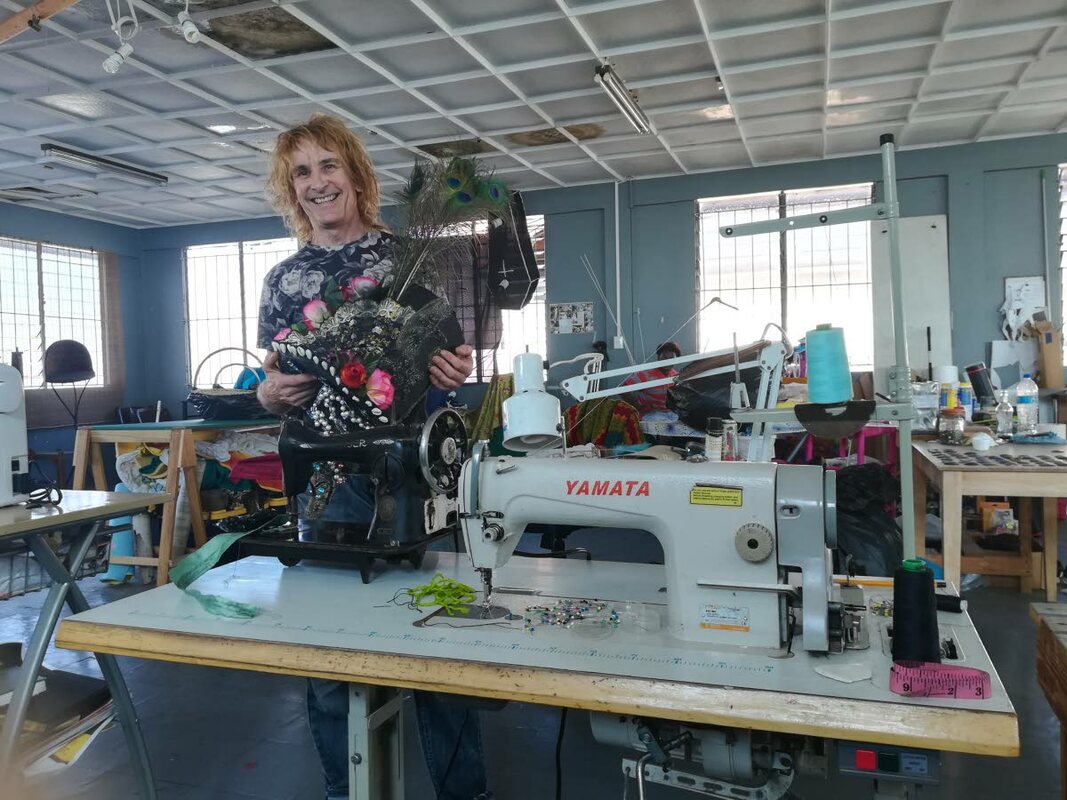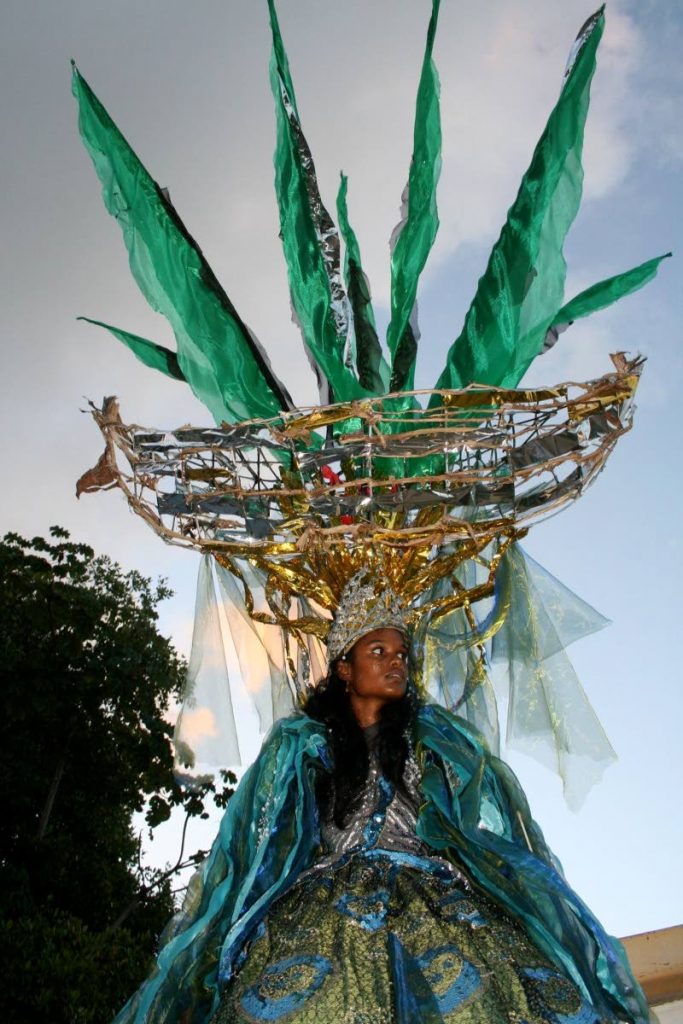|
Vintage Singer: British designer Alan Vaughan prefers to use an old Singer machine over the modern plastic machine at the Granderson Lab, Erthig Road, Belmont. Photo by Josh Surtees During his 20-year love affair with Trinidad Carnival, British mas man Alan Vaughan has won competitions and friends along the way. This year he’s back with another stunning West African-themed moko jumbie band. From the back stairs of a spacious open-plan studio, Alan Vaughan gazes over the rusty rooftops of Belmont. In the distance, the spire of St Margaret of Antioch Church pokes its head up. Beyond it, the green hills undulate towards Morvant. “It’s all very close together,” he says, looking at the tightly packed houses in Port of Spain’s oldest neighbourhood. He’s been encamped in Belmont for weeks, making mas for his new band Moko Somokow. After posing for a picture, Vaughan returns to his desk in the workspace he shares with other artists. His friend and collaborator Kriston Chen has just brought him a vintage Singer sewing machine. “I prefer these old solid ones to the modern plastic,” he says pointing at the other sewing machines on the tables around him. He’s upstairs at Granderson Lab (the G and R have fallen off the sign on the door) on Erthig Road. The former printing press was taken over a few years ago by the owners of Alice Yard and turned into a workshop for a fashion company and other artistic enterprises. It’s a drastic change from Vaughan’s usual setting in Newcastle, north-east England and a departure from the familiar surroundings of Taradale where his erstwhile moko jumbie band, Touch D Sky, are based. He’s been coming to Trinidad for 20 years and since 2012 the two-phase housing development built on former cane fields outside San Fernando has been his Carnival headquarters. “We started off in a squat in an empty house and the police came and threw us out, so we ended up making the whole mas in one of the boys’ bedrooms,” he laughs. In the five years since Touch D Sky’s founders, Adrian Young and Jonadiah “JJ” Gonzales, invited Vaughan (“Mr Alan” to his friends) to design for the band, he has not only learned how to sew (his background is in sculpture and painting) but also taught himself how to stilt-walk. “We wanted to move things on,” he explains. “Up until then the whole experience of being a moko jumbie was being called up to ‘do a run’ at a fete…there were no moko jumbies saying ‘we want to bring out our own mas.’” By 2015, he had moved things on to a level nobody could have predicted, becoming the first British designer in history to win the Carnival Queen competition when Stephanie Kanhai performed Sweet Waters Of Africa dressed in Vaughan’s interpretation of the African goddess Oshun. Queen of Carnival: Stephanie Kanhai won the 2105 Queen of Carnival crown in her portrayal of The Sweet Waters of Africa, designed by Alan Vaughan. Photo courtesy Alan Vaughan Smiling at the judges from ear to ear, Kanhai also became the first moko jumbie to win the crown. “People still grumble about that now,” says Vaughan. “Moko jumbies aren’t supposed to win when you have people entering these big expensive float designs.” The boat-shaped headpiece Kanhai wore symbolised, he says, “the African blood that travelled over the Atlantic and is still flowing on this side of the Atlantic.” His mas band that year was named Crossing the River, after the Caryl Phillips novel about the global migration of African culture. The book was an epiphany for Vaughan who had become besotted with West African culture, art and religion since visiting Afrocentric parts of Brazil in the 1990s. “There’s a parallel world going on in Brazil that’s right obvious and I found it really hard to find in Trinidad – for years I couldn’t see it. Even in Rio, a big commercial city, on a street corner you’ll see some flowers, a candle, some cigarettes and a bit of rum, for Eshu.” “New Year’s Eve, Copacabana beach is just full of people sending little boats out for Yemanja. It’s part of so many people’s lives – the spiritual life going on at the same time as the physical. Bata drums in the night, paper balloons crossing the sky for St Anthony.” With Touch D Sky on hiatus for 2018, Vaughan has launched the spin-off band Moko Somokow (meaning “spirit family” in Mali’s Bambara language) and has decided he will perform in the Carnival King competition himself, for the first time. “I want to walk across that stage,” he says, smiling. “Before I’m too old.” His entry is called The Magnificent Return of Sundjata, after the king who united the 12 tribes of Mali together to form an empire in the 13th century. Griots in Mali still tell the epic of his prophecy, birth and return from exile. The aesthetic themes of the costume are familiar to followers of his work – richly coloured fabric adorned with shimmering pieces of material that flutter like bird feathers, and swirly sequined patterns that glitter in the light. Asked what his artistic inspirations are – leaving aside the fact he has played mas in bands by Peter Minshall and Brian Mac Farlane – he somewhat surprisingly references medieval paintings. “It’s the richness of the detail and because they’re not dealing with reality.” Growing up in Gloucestershire in rural south-west England, he was a punk rocker with orange hair, a plastic rain mac and Day-Glo socks by the time he left home to attend Cheltenham College of Art and Design in 1978. “That was my awakening year,” he says nostalgically. “I’d failed my art A-Level but they’d given me a place anyway and when I got there they said, ‘well that’s great, everyone who fails is a far better artist.’” “It was the year that taught me to think. I still remember the head of fashion saying, ‘I always look at fashion like body sculpture.’” That statement has followed him through his life’s work and still informs his mas making today. He went on to study fine art at the University of Nottingham, then took a job as artist in residence on the psychiatric ward of a hospital in Newcastle – the city he now calls home – before raising funds to open the North Tyneside Arts Studio, which caters for people with mental health problems. By the mid-90s, a Conservative government that had decimated public funding in Britain for everything from hospitals to school meals had begun withdrawing support from arts projects, including his. Depressed at constant attempts to shut down the thing he had built, Vaughan took the advice of a Trinidadian roommate and came over for Carnival. “I would come and shut myself away in Maracas Valley and not speak to anyone for three months and just make bits of art out of junk,” he chuckles. “I didn’t know any artists, I wouldn’t go and socialise, it was just my time.” Trinidad was a life-changing experience for Vaughan, particularly his fascination with moko jumbies “appearing out of nowhere.” “And it’s often these quite unruly young lads, so there’s this hint of danger and menace going on, you don’t know what’s going to happen.” He shares some of these experiences back in grey, drizzly Newcastle, teaching children moko jumbie walking at a local community centre. In 2015, he brought one of them down to the British Museum in London and flew Kanhai and Gonzalez over from Trinidad, to perform together for crowds outside the world-famous institution. But despite his fondness for the Caribbean and for Europe, Vaughan’s heart really lies in Africa. “Africa is a different way of thinking,” he says. He recalls a conversation he once had with the “mesmeric” South African professor Pitika Ntuli, who told him a story about the Ndebele women who paint their houses with geometric shapes, “almost like Mondrian paintings” and in the rainy season it all washes off. “This British missionary aid worker goes over there and tells them about this exterior household paint, and the women just look at him in horror saying, ‘why would we want to do that?’ And the missionary says, ‘so it won’t wash off and you don’t have to redo it.’ So the women tell him, ‘but we’ll want a different pattern next year because our lives will have changed.’” Ntuli’s conclusion was that the European view of art is to create “little forevers”, like paintings that are exhibited and preserved for centuries, while in Africa they are “forever creating”. “You do something, it has a purpose and then life moves on and you recreate.” The annual, seasonal renewal of Trinidad Carnival is arguably similar, even if the inspirations hark back to longstanding traditions. But what inspires Vaughan to make mas? He sums it up quite simply but poetically. “It’s the same as writing a novel. You do it because you think there’s something important to say, but you hope other people are going to read it and enjoy it.” Source: Newsday, January 27, 2019  King Eshu: Jonadiah Gonzales appears to fly out of the trees as Eshu Ajagura, a Carnival king designed by Alan Vaughan in 2016. Photo courtesy Alan Vaughan.
0 Comments
Leave a Reply. |
T&T news blogThe intent of this blog is to bring some news from home and other fun items. If you enjoy what you read, please leave us a comment.. Archives
May 2025
Categories
All
|



 RSS Feed
RSS Feed